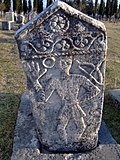| Old Jewish cemetery Kovačići | |
|---|---|
| Staro jevrejsko groblje Kovačići | |
 | |
| Details | |
| Established | 1630 |
| Abandoned | closed |
| Location | Sarajevo |
| Country | Bosnia and Herzegovina |
| Type | Jewish |
| Owned by | City of Sarajevo |
| Size | 31,160 square metres (7.70 acres) |
| No. of graves | >3850 |
| KONS of Bosnia and Herzegovina | |
| Official name | Jewish cemetery in Sarajevo, the burial ground ensemble |
| Type | Category I cultural monument |
| Criteria | A, B, C i.ii.iii.iv.v.vi., D i.ii.iii.iv.v., E iii.v., F, G v., H, I i.ii.iii. |
| Designated | 30 August 2004 (?th session) |
| Reference no. | 07.2-02-201/04-4 |
| State | National Monuments of Bosnia and Herzegovina |
The OId Jewish Cemetery is a cemetery in Sarajevo, Bosnia and Herzegovina. It is located on the slopes of Trebević mountain, in the Kovačići-Debelo Brdo area, in the south-western part of the city. It is the largest Jewish cemetery in Southeast Europe, and second largest sepulchral complex in Europe after the Old Jewish Cemetery in Prague. It was in use for approximately four hundred years from the beginning of the 16th or 17th century, but most likely from 1630 until 1966.
History
Established by Sephardic Jews in 1630, in Sarajevo during the Ottoman period. It also became the burial ground for Ashkenazi Jews after they arrived in Sarajevo with the Austro-Hungarian Empire in the late 19th century. It contains more than 3850 tombstones and covers an area of 31160 square meters. It has four monuments dedicated to the victims of fascism: a Sephardi one designed by Jahiel Finci and erected in 1952, two Ashkenazi ones, and one dedicated to the victims of Ustasha militants.
During war of the 1990s
The Jewish Cemetery was on the front line during the war in Bosnia and Herzegovina, and was used as an artillery position by Bosnian Serbs. It was thus severely damaged by bullets and fire caused by explosions. It was also heavily mined but was completely cleared in 1996.
Notable burials and memorials
Notable people buried in the cemetery include Rabbi Samuel Baruh (first rabbi of Sarajevo from 1630 to 1650; his grave is believed to be the oldest in the cemetery), Rabbi Isak Pardo (rabbi from 1781 to 1810), Rabbi Avraham Abinun (Grand Rabbi from 1856 to 1858), Moshe ben Rafael Attias (1845 – 1916), Laura Levi Papo LaBohoreta (writer of the early 20th century), and Isak Samokovlija. There are also four memorials erected to the victims of Fascist terror, along with several cenotaphs, an empty memorial tombs, with the names of people who died elsewhere and whose grave locations are unknown.
Genizah
Separate vault or "grave" for damaged books known as a Genizah, is located in the southeastern part of the cemetery, with the first burial taking place on 3 July 1916. Assumption is that some 14 chests of holy books were buried in the second burial ceremony, so currently exhumation of Geniza is under way to determine its content.
National and World Heritage designation
The cemetery is designated as a national monument of Bosnia and Herzegovina under the name "Jewish cemetery in Sarajevo, the burial ground ensemble". In preparation for nomination for inclusion on the World Heritage Site list, Bosnian delegates submitted "Sepulchral ensemble – Jewish cemetery in Sarajevo" documentation for the tentative list at UNESCO on April 3, 2018, under the "Cultural" category and criteria "(ii)", "(iii)", "(iv)", "(vi)".
Gallery
-
 The main gate with a fountain
The main gate with a fountain
-
 Inscription over the main gate
Inscription over the main gate
-
 Temple (Ciduk Adin) near main entrance with an old wall
Temple (Ciduk Adin) near main entrance with an old wall
-
 Old wall from the main gate western edge
Old wall from the main gate western edge
-
 View on city
View on city
-
 Cityscape from the top of the cemetery
Cityscape from the top of the cemetery
-
Cemetery
-
 Inscriptions on the tombstones
Inscriptions on the tombstones
-
 Winter ambient
Winter ambient
-
Traces of mortar shells and bullet holes
-
 Cemetery second half of the 19th century, beginning of the Austro-Hungarian period
Cemetery second half of the 19th century, beginning of the Austro-Hungarian period
-
 Upper gate, highest point at the southern edge
Upper gate, highest point at the southern edge
See also
References
- ^ Permanent Delegation of Bosnia and Herzegovina to UNESCO. "Jewish Cemetery in Sarajevo". whc.unesco.org. UNESCO World Heritage Centre.
- ^ "Jewish cemetery in Sarajevo, the burial ground ensemble". old.kons.gov.ba. Sarajevo: Commission to preserve national monuments. 30 August 2004. Retrieved 26 May 2023.
- Petersen, Hans-Christian; Salzborn, Samuel (2010). Antisemitism in Eastern Europe: History and Present in Comparison - Google Books. ISBN 9783631598283. Retrieved 2013-09-06.
- "JEWISH CEMETERY Sarajevo Bosnia and Herzegovina" (PDF). Coe.int. Retrieved 17 August 2013.
- "U.S. Commission Urges Sarajevo Cemetery Restoration". Isjm.org. Archived from the original on 27 February 2019. Retrieved 17 August 2013.
- Malcolm, Noel (October 1996). Bosnia: A Short History - Noel Malcolm - Google Books. ISBN 9780814755617. Retrieved 2013-09-06.
- "Jewish Women in Yugoslavia". Jwa.org. Retrieved 17 August 2013.
- Šimić, Angelina (5 February 2018). "Oslobođenje - Očekuje se upis Jevrejskog groblja u UNESCO". Oslobođenje d.o.o. (in Bosnian). Retrieved 31 May 2018.
External links
 Media related to Jewish cemetery Sarajevo at Wikimedia Commons
Media related to Jewish cemetery Sarajevo at Wikimedia Commons
| Topics | |
|---|---|
| Groups | |
| Synagogues |
|
| Cemeteries | |
| Cultural institutions | |
| People | |
